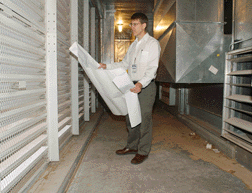FOR IMMEDIATE RELEASE
December, 12, 2001
Sandia develops tools for assessing vulnerability of buildings to chemical and biological attacks
|

SANDIA RESEARCHER Richard Griffith studies blueprints of a building to better understand airflow. He has led a team that developed modeling and simulation tools for assessing the threat and vulnerability of buildings to biological and chemical assaults. This includes looking at how these agents move and are deposited inside a building. (Photo by Randy Montoya)
Download 300dpi JPEG image, ‘griffith.jpg’, 1.1MB (Media are welcome to download/publish this image with related news stories.)
|
ALBUQUERQUE, N.M. — A research team from the Department of Energy’s Sandia National Laboratories has developed modeling and simulation tools for assessing the threat and vulnerability of buildings to chemical and biological attacks.
This includes looking at how agents move and deposit inside a building, developing and assessing mitigation strategies, guiding the use of detection methods, and examining the effectiveness of cleanup and decontamination efforts.
Sandia researcher Richard Griffith began working on the project following the 1995 sarin gas release in Tokyo’s subway system where it became apparent that chemical and biological attacks by terrorists could be a future trend.
Using sophisticated Sandia-developed computer modeling and visualization capabilities, he can simulate how various chemical and biological agents — such as anthrax, smallpox, sarin, and mustard gas — flow through a building and deposit on various surfaces.
“We start by mapping out the building and creating a computational model from the electronic AUTOCAD© blueprints, including all the rooms and areas served by each air handler and all the air ducts,” Griffith says. “Then we simulate the release of a chemical or biological agent directly into different parts of the building, or from the outside for exterior releases.”
The computer model, known as KCNBC, predicts where the agent will move as a function of time following its release, producing a movie that gives researchers a view of agent transport and concentration. Simulations include a variety of agent release scenarios using real properties for a number of chemical and biological materials.
This modeling capability has been applied to several facilities, including an eight-story federal courthouse, a military command and control center and a large airport terminal building.
Supported by Energy Secretary
Secretary of Energy Spencer Abraham strongly supports efforts such as this. “Innovative technology to protect America today and prevent threats for tomorrow is the cornerstone of our critical infrastructure security,” says Abraham, “and I’m excited about what DOE’s national laboratories are doing to further our national security.”
Since Sept. 11, Griffith has received numerous inquiries from government agencies and others about how to assess the chem/bio threat and the vulnerabilities of their buildings.
The information produced by the computer simulations is valuable in determining cost-effective mitigation strategies, figuring out where to put agent detection sensors, sensor performance requirements, and deciding on cleanup and decontamination tactics.
In the area of mitigation, for example, the simulations might provide insight as to whether some or all of the air handlers should be turned off in a contaminated building, if it would be effective to purge the contaminated air and pump in fresh air, if it might be possible to contain or isolate the agent using the HVAC (heating, ventilation, air conditioning) system or if filters or neutralizers should be used. The benefits of any given mitigation strategy can be assessed to help pick the most useful and cost-effective approaches to protecting the building.
The modeling data could also guide the optimal placement and use of sensors for detecting chemical and biological agents.
“These new sensors are expensive, and may have significant installation and maintenance costs,” Griffith says. “If you can only have five or six of them to help protect a large building, you have to figure out the most effective places to put them.”
Questions then arise of how sensitive the sensors must be and how fast must they respond. For example, asks Griffith, would a sensor with a five-minute response time help, and where would fast or slow sensors be appropriate? What sensor sensitivity is needed to effectively protect the building by initiating active responses? The modeling and simulation tools help answer those questions.
Cleanup and decontamination efforts could also benefit from computer modeling. The models can predict agent deposition on floors, walls, ceilings, ducts, and other surfaces in every room of the building, providing information about where the agent could go and what areas of a building could be the most contaminated. The information could allow cleanup efforts to be focused on the most contaminated areas, giving insight about where cleanup efforts should begin and where they are less needed.
Finally, Griffith says, the modeling and analysis tools are critical technologies in creating a “smart building,” one that integrates sensor information and observations from human security to “know” what is happening in and around the building, and then uses predictive modeling and decision-making algorithms to chose the most effective responses to protect building occupants. When sensors detect the presence of an agent, a “smart building” would chose the best HVAC system response to create clear evacuation paths or areas of the building where occupants could take shelter, provide real-time instructions to occupants and first responders, and minimize the amount of the building that was contaminated.
“There are a lot of things we can do to better protect building occupants against chemical and biological contamination,” Griffith says. “These modeling and analysis tools can play a key role.”
Sandia is a multiprogram laboratory operated by Sandia Corporation, a Lockheed Martin Company, for the United States Department of Energy under contract DE-AC04-94AL85000. With main facilities in Albuquerque, N.M., and Livermore, Calif., Sandia has major research and development responsibilities in national security, energy and environmental technologies, and economic competitiveness.
Sandia Media Contact:
Chris Burroughs, coburro@sandia.gov, (505) 844-0948
Sandia Technical Contact:
Richard Griffith, rogrif@sandia.gov, (505) 844-8232
|
